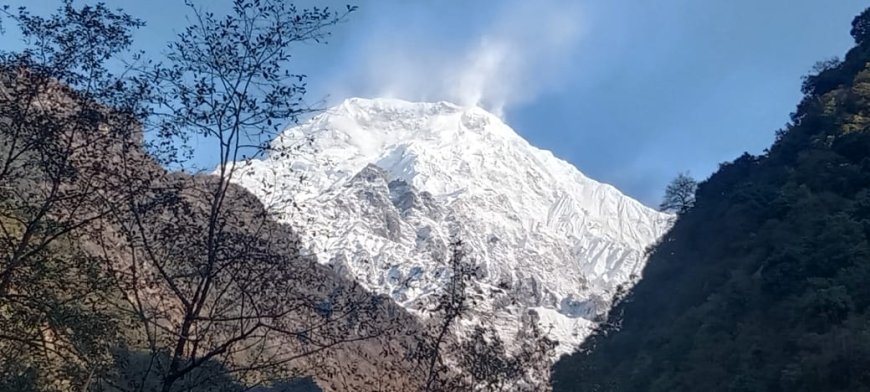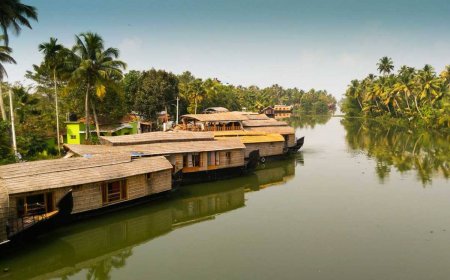How to Make You Feel Alive On This Daring Adventure
Trek the Annapurna Circuit, Nepal’s iconic trail offering Himalayan peaks, deep gorges, and cultural villages in one epic loop.

Starting yourAnnapurna trek, its not just hiking several kilometers; its the invitation to every nerve you have to wake up and feel alive. From contact down in this exciting journey, you'll no longer be on autopilot, a slave to everyday routine, normal, there's something to experience, see, do, and enjoy - a tale is constructed into each beat that drives your motive ahead. Snow-protected, colossal mountains, crystal-clear, gushing streams meandering through emerald valleys, and far-off villages where vintage customs abound coalesce into a sensory symphony that throbs with existence.
The magic of Annapurna is in its contrasts: teahouse owners with heartwarming hospitality and icy gusts within the heritage, the solitary silence of morning prayer flags streaking the solar-afflicted air contrasted with exhilarating ridge line climbs, and the shared warmth of dal bhat dinners combined with the breathtaking grandeur of the sectors highest mountains. Here, the obstacles cause excitement. A lightning storm materializes as an exhilarating test of preparation; a tough ascent becomes a triumph of endorphins; a fitful night of high?altitude sleeplessness becomes a profound lesson in self?discovery and inner strength.
In this post, well delve into six key ways to amplify your aliveness on the Annapurna trek: from the practice of mindful rituals that bring you back to the here and now, to the development of physical and mental strategies that turn hard times into good times, and from the creation of authentic links with local culture through to recording the pulse?quickening moments that set your soul on fire. If you are a seasoned climber or new high?altitude traveler, this knowledge will enable you to do more than just make the trip live the journey, passionately and vibrantly.
MORNING MINDFULNESS: exercise it at the same time as Surrounded by Mountain Majesty
start early within the morning, before the sun rises, and the mountains are painted in tender gold. Accept a moment right into a non-violent perch a teahouse porch, a stone outcropping, the trail and close your eyes for a little meditation.Be aware of the sound of wind fluttering prayer flags, a miles-off clinking of tea kettles, and your breath falling consistent with the heartbeat of the herbal globe. Its an easy act that focuses your thoughts, sharpens your senses, and prepares your body for an adventure. Whilst you live rooted within the 2d, you intensify each sensationfrom the cold caress of your skin to the first suggestions of mild at the far-off ridgelinepermitting you to awaken and feel completely alive.
include physical problems because the Engine of pleasure
Undulating anywhere from sea level to 000 km above, steep climbs, rocky scrambles, and high?altitude passes are not insurmountable obstacles on the trail; they are reminders that no obstacle is insurmountable in life. approach each climb with curiosity, not with fear. Feel the muscle activation, lungs fill, and coronary heart price quicken as you crest that next ridge. Those are the micro?victories (like tackling a difficult phase or reaching a brand new point of view) that make the endorphin rush of excitement even sweeter. By viewing effort as a pleasure, even my feet-hardening slogs became opportunities for ecstatic aliveness.
Experience the actual lifestyle of Sherpa lifestyle
engage with the Sherpa and Gurung villagers to characteristic a cultural twist to your trek. Observe primary greetings in Nepali, sip a cup of butter tea, or participate in a prayer ceremony in a hillside gompa. Being gifted as elders, telling mountain legends, turning into a member of communal meals, and journeying to family?run teahouses offer a cultural immersion that roots your journey in human warmth. These are the actual moments, and they elicit empathy and gratitude simply as they did at the path, reminding you that the maximum valuable treasures out at the path are the relationships you make and the stories you do away with with you.
Harness power via Breathwork & movement
Whilst sleepiness or elevation looms, you could depend upon truthful breathwork and lively movement to restore and refresh your body and mind. Use deep diaphragmatic breathing breathing in absolutely through the nostrils and exhaling slowly via the mouth to boost the amount of oxygen in your cells and settle your nerves. Combine this with a few mild yoga poses or lunges assisted through a pair of hiking poles that open up the chest and the hips.These practices do relieve the stiffness and breathlessness; they do get the circulation and the mind going. Using the mindful power of movement and breath, you transform exhaustion into rejuvenating energy flow.
Shoot Adrenaline While Being Safe and Tactical
During the day, look for adrenaline-spiking but doable adventures like walking along rockside ledges from a sheer valley below, walking along the narrow top of a ridgeline with views, or crossing the current of a river via a suspension bridge. Put together a danger assessment, take a look at the weather, and have a comfy footing earlier than venturing out on a courageous segment. Spend money on hiking poles, suitable footwear, and a constant pace. At those peaks of adrenaline, pause and appreciate the intensity: sense the racing of your coronary heart, the starvation on your lungs for greater oxygen, and the arena sharpen into vividness. Take a picture, write about this, so that you may come back to this rush, remember that those were feelings of being alive. Right here are some rituals to mirror and have fun with gratitude.
On the quiet of the day, block out a while for meditation. Mild a candle to your teahouse, jot down a gratitude list in your magazine, or evaluate highs and lows with fellow trekkers over steaming dal bhat. Appreciating obstacles already surmounted and gifts already bestowed secures what the day has taught me. When you give thanks to your body, to the mountains, to those you meet, you construct a frame of mind that finds its way into each dawn that follows. Those gratitude ceremonies build the motive and the connection, so by using the cease of the trail, you're more alive than you have ever been after every step on the Annapurna.
What's the mortality rate for the Annapurna Base Camp Trek?
Annapurna Base Camp (ABC) trek death perquisition relative safety while as compared to hiking high mountains, the Annapurna Base Camp (ABC trek) is generally secure and has very low fatality statistics.
Most accidents on the trail are caused by altitude sickness, slipping, and health problems, not extreme mountain risks. Although exact numbers arent widely reported, deaths are relatively rare on AB because the route doesnt require technical climbing, and the main point of acclimatization is to an elevation of only about 4,130 meters (which is not high for acclimatized trekkers).
Is it possible to do the Annapurna Circuit alone?
The Annapurna Circuit trek is an unbiased trek: sure, you could do the Annapurna Circuit trek on your very own. It is a nicely trodden, busy direction with lots of teahouses en route, so there may be no hassle with navigation or lodging. However, for freeloaders and beginners, or all of us now not experienced with high-altitude hiking or seeking local facts and further protection, it's beneficial that you rent a manual. (1) Trekking solo- This calls for good preparation, good physical condition, and an understanding of altitude sickness dangers.
Why is Annapurna loved more than Everest?
Humans prefer Annapurna over Everest because Annapurna allows them to experience a range of routes and variety in preference to the commercialization of the alternative. The Annapurna vicinity gives a wealth of cultural variety, from Hindu villages to Tibetan-recommended settlements, various terrain from lush sub-tropical forests to harsh, semi-arid deserts, and fewer crowds. Annapurna treks tend to be much less difficult and much less touristy, so you will enjoy a quieter but no less dazzling Himalaya journey than within the busier Everest location.
How tough is ABC?
Annapurna Base Camp trek starts with a moderate shape of trek. It provides five hours of hiking each day, on the entirety from steep stone steps to uneven paths. The summit reaches four, 130 meters (550 ft) above sea level, and altitude contamination can be an issue. Although it might not involve technical mountaineering, you continue to need to be suitable, well-acclimated to the high altitude, and mentally prepared for a fast and energetic trek.



















